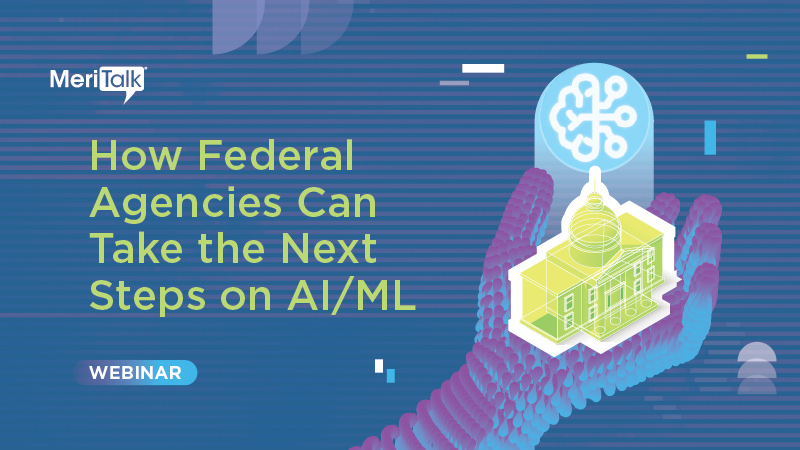
The age of artificial intelligence (AI) is upon us. AI is everywhere, dominating headlines and conversations as it and machine learning (ML) technologies advance toward adoption at a rapid pace.
Federal spending on AI has risen to record levels, and the Biden administration’s fiscal year 2024 budget seeks billions of dollars more, while AI-related legislation has increased exponentially in Congress. Federal agencies and mission partners are already hard at work implementing AI-infused solutions to support a wide range of missions.
The Department of Veterans Affairs (VA), for example, will begin using AI tools to reduce provider burnout at its medical facilities, Dr. Rafael Fricks, the associate director for AI in medical imaging at both the VA’s MAVERIC Informatics Group and the National Artificial Intelligence Institute, explained during MeriTalk’s “How Federal Agencies Can Take the Next Steps on AI/ML” webinar on January 9.
According to Fricks, President Biden’s recent AI executive order tasked the VA with conducting two AI tech sprints per year.
“We’re currently in the process of planning, preparing, and we’re about to actually engage in one of these first tech sprints, which is centered around reducing provider burnout,” Fricks said. “This is burnout of our physicians, of our nurses, of all our staff that are patient-facing especially.”
“One of the key things that we heard in talking to these staff and working with our various different offices across the VA, is that there’s a lot of overhead now with documenting a patient encounter, with receiving other documents, and ensuring that everything is traceable,” he said.
Fricks explained that leveraging AI to reduce provider burnout across the VA will have two tracks. The first involves AI interpreting ambient dictation – whether that be a conversation between a patient and their provider, or even perhaps the doctor wants to dictate their notes after the encounter.
Secondly, the VA is focused on leveraging AI tools within its community care program. When the VA cannot provide care to its veterans, it will often send them out into the community to receive healthcare from a specialist, Fricks explained. But when the patient comes back to the VA, they have health records from their appointments with outside providers that the VA then must integrate back into its systems. AI, Fricks said, can help with this task.
The VA is also using AI for small but mighty tasks like customer service, Fricks explained. In 2019, the department stood up the National AI Institute, which works across various offices to improve processes for veterans.
“In terms of using AI and ML for customer service, that goes back to that low hanging fruit in the sense that we want to use these generative technologies and chatbots and so on to help veterans navigate our services, help them explore what benefits might be available to them, help them better understand the process,” Fricks said.
Specifically, the VA is leveraging AI to address a “real pain point” for veterans: transitioning out of the military and into the VA healthcare system.
“Those are places where AI can serve as a force multiplier,” Fricks said. “It’s not making a life-or-death medical decision immediately, but it is certainly helping us review cases faster and hopefully getting the veterans in the care faster.”
“Of course, there’d be manual review of every decision made by AI,” Fricks added. “This is to ensure that there is an explanation about why a decision was made … At the end of the day, [AI] is to assist our staff in making their decisions faster – not to supplant their decision making. We are not at the point of really taking humans out of the loop; we just want to make sure that we can get to all our veterans in a timely manner.”
There are many use cases for AI across the Federal government, with a recent Government Accountability Report tallying up nearly 1,200.
“Federal agencies are enthusiastic about AI,” said George George, a solutions architect at REI Systems – which works with Federal agencies to optimize business processes and innovate with AI and ML.
To get the most value from AI tools, George advised agencies in MeriTalk’s special report released on January 9 to “assess and clearly identify their goals; identify applications that enhance customer, citizen, and staff experience, addressing pain points with intelligent automation; and ensure governance that is enforced with the appropriate guardrails to ensure ethical and responsible use of AI.”
George cited specific successful implementations, such as the Internal Revenue Service using AI and ML to identify tax fraud patterns, and national security use cases that include the Department of Homeland Security and the National Security Agency applying both technologies to detect cybersecurity threats with predictive algorithms.
Imran Chaudhri, chief architect for healthcare and life sciences at MarkLogic – which works with Federal agencies to simplify complex data – said generative AI systems pose “some key problems that need to be navigated very carefully.”
These include “hallucinations in which they confidently provide plausible but incorrect data 15 to 20 percent of the time. In human terms, these are like memory errors, creativity, or lies,” Chaudhri said. “Other AI model issues include biases based on bad data, reasoning errors, knowledge cutoffs, and struggling at specific tasks.”
In the end, he said that a good way to ensure responsible and effective use of AI is to simply use it more. Since “the generative space has been booming,” Chaudhri said, Federal agencies should consider adding generative AI to areas such as knowledge management of private data, conversational services and communications, and content design and generation.
“The Federal government holds oceans of private data,” he said, which means that “making sense of it via knowledge management, intelligent synthesis, natural language exploration and discovery of this private data will improve the government’s capabilities and efficiency.”
Watch MeriTalk’s “How Federal Agencies Can Take the Next Steps on AI/ML” webinar on demand here, and download our coinciding special report on AI/ML here.
